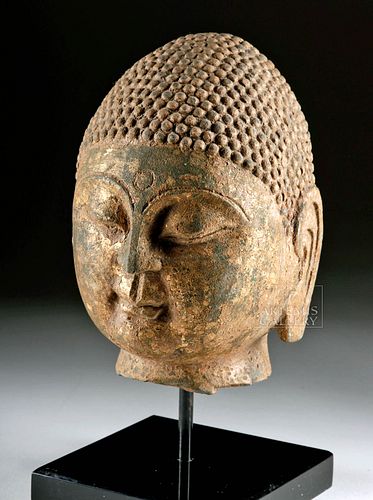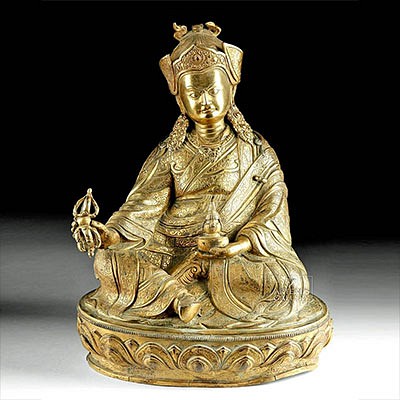Chinese Qi Dynasty Gilded Stone Buddha Head
Lot 1
About Seller
Artemis Fine Arts
686 S Taylor Ave, Ste 106
Louisville, CO 80027
United States
Selling antiquities, ancient and ethnographic art online since 1993, Artemis Gallery specializes in Classical Antiquities (Egyptian, Greek, Roman, Near Eastern), Asian, Pre-Columbian, African / Tribal / Oceanographic art. Our extensive inventory includes pottery, stone, metal, wood, glass and textil...Read more
Categories
Estimate:
$12,000 - $15,000
Absentee vs Live bid
Two ways to bid:
- Leave a max absentee bid and the platform will bid on your behalf up to your maximum bid during the live auction.
- Bid live during the auction and your bids will be submitted real-time to the auctioneer.
Bid Increments
| Price | Bid Increment |
|---|---|
| $0 | $25 |
| $300 | $50 |
| $1,000 | $100 |
| $2,000 | $250 |
| $5,000 | $500 |
| $10,000 | $1,000 |
| $20,000 | $2,500 |
| $50,000 | $5,000 |
| $100,000 | $10,000 |
| $200,000 | $20,000 |
About Auction
By Artemis Fine Arts
Mar 11, 2021
Set Reminder
2021-03-11 12:00:00
2021-03-11 12:00:00
America/New_York
Bidsquare
Bidsquare : Art of Asia | Antiquity to Present
https://www.bidsquare.com/auctions/artemis-gallery/art-of-asia-antiquity-to-present-6497
Featuring antiquities, ancient and works of art ranging from the third millennium BCE to the present from China, Japan, South and Southeast Asia, and Korea. Including jades, bronzes, lacquer, textiles, paintings, prints, sculpture, ceramics, metalwork, and other art forms in other media. Artemis Fine Arts info@artemisfinearts.com
Featuring antiquities, ancient and works of art ranging from the third millennium BCE to the present from China, Japan, South and Southeast Asia, and Korea. Including jades, bronzes, lacquer, textiles, paintings, prints, sculpture, ceramics, metalwork, and other art forms in other media. Artemis Fine Arts info@artemisfinearts.com
- Lot Description
East Asia, China, Northern Qi Dynasty, ca. 550 to 577 CE. An incredibly preserved limestone carving of the head of Buddha, with nice remaining dark pigment, especially on the hair, and gilding on the face. The face shows the influence of Chinese artists on Buddhist imagery, with the Buddha's face depicted as broad, split in half by a thin nose descending from the elegantly arched eyebrows. A small, full-lipped mouth is above the dimpled chin. The eyes are large, with heavy lids, and downcast. The ears are also large, with a spiral shape at the top and elongated lobes, referencing the wealth of Prince Siddhartha before he became enlightened. The head is gently conical and covered in densely packed relief dots to give the impression of tightly curled hair. A clear urna - a dot symbolizing enlightenment - is on the forehead. The hair is painted a dark color, while the face is gilded over black - now faded to dark green - paint. Size: 5.15" W x 8.2" H (13.1 cm x 20.8 cm); 11.45" H (29.1 cm) on included custom stand.
Around the 1st century CE, Buddhism came to China along the Silk Road from India; it brought with it an entirely new visual and artistic iconography. The northern rulers of China in the mid-1st millennium CE sponsored the creation of much beautiful and artistically distinct Buddhist artwork. This example is characteristic of the sculpture produced in Shandong province, northeastern China. The discovery in 1996 of over 400 Buddhist sculptures - broken heads and hands, and hundreds of intact torsos, many with gilding and paint still in good condition - in a field that was once the site of a Buddhist monastery in Qingzhou has allowed archaeologists to understand the artwork of this time period much better. The Qingzhou discovery was the largest known group of such sculptures, but other small caches have been found since the 1970s elsewhere in northeastern China. Fascinatingly, most of these sculptures were made during the Northern Qi period, but were buried - based on coins found alongside them - in the 12th century CE, six hundred years later. This seems to have been done to protect the beautiful artwork from the Qi period from anti-Buddhist sentiment.
See a very similar example at the Metropolitan Museum of Art: https://www.metmuseum.org/art/collection/search/60794
Provenance: private Vero Beach, Florida, USA collection aquired in the mid 80's from an old English collection
All items legal to buy/sell under U.S. Statute covering cultural patrimony Code 2600, CHAPTER 14, and are guaranteed to be as described or your money back.
A Certificate of Authenticity will accompany all winning bids.
We ship worldwide and handle all shipping in-house for your convenience.
#144228Head is a fragment from a larger sculpture and the neck is rough. Much of the original gilding and pigment remains and nice deposits are on the surface. Excellent remaining detail.Condition
- Shipping Info
-
All shipping is handled in-house for your convenience. Your invoice from Artemis Gallery will include shipping calculation instructions. If in doubt, please inquire BEFORE bidding for estimated shipping costs for individual items.
-
- Buyer's Premium



 EUR
EUR CAD
CAD AUD
AUD GBP
GBP MXN
MXN HKD
HKD CNY
CNY MYR
MYR SEK
SEK SGD
SGD CHF
CHF THB
THB














